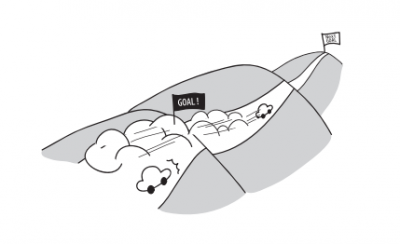Difference between revisions of "Acceleration to Next/OG"
Sfrancisco (talk | contribs) (Created pattern in original format) |
Sfrancisco (talk | contribs) (Added category) |
||
| (3 intermediate revisions by the same user not shown) | |||
| Line 4: | Line 4: | ||
{{Infobox_designpattern | {{Infobox_designpattern | ||
|image= <!-- Provide the filename of the image to be displayed (e.g., Design_pattern.png) --> | |image= <!-- Provide the filename of the image to be displayed (e.g., Design_pattern.png) --> | ||
|contributor= | |contributor= [[Takashi Iba]], [[Toko Miyake]] | ||
|source= Iba & Miyake (2010)<ref>Iba, T., & Miyake, T. (2010). [http://dl.acm.org/citation.cfm?doid=2371736.2371742 Learning Patterns: a pattern language for creative learning II]. In ''Proceedings of the 1st Asian Conference on Pattern Languages of Programs'' (p. 4). ACM: | |source= Iba & Miyake (2010)<ref>Pattern published in Iba, T., & Miyake, T. (2010). [http://dl.acm.org/citation.cfm?doid=2371736.2371742 Learning Patterns: a pattern language for creative learning II]. In ''Proceedings of the 1st Asian Conference on Pattern Languages of Programs'' (p. 4). New York:ACM.</ref>; Iba (2010)<ref>Patlet mentioned in Iba, T. (2010). [https://pdfs.semanticscholar.org/6e59/51c886e73a6efdc88f7be185d2f9336025ef.pdf Designing a Pattern Language for Creative Learners].</ref> | ||
|dataanalysis= <!-- If applicable, list of data analyses used for mining the pattern separated by a " , "comma --> | |dataanalysis= <!-- If applicable, list of data analyses used for mining the pattern separated by a " , "comma --> | ||
|domain= <!-- Learning domain the design pattern belongs to (e.g., General, Math, Algebra) --> | |domain= <!-- Learning domain the design pattern belongs to (e.g., General, Math, Algebra) --> | ||
| Line 54: | Line 54: | ||
<references/> | <references/> | ||
[[Category:Design_patterns]] <!-- List of other categories the design pattern belongs to. The syntax for linking to a category is: [[Category:<Name of category]] --> | [[Category:Design_patterns]] [[Category:Full_Pattern]] [[Category:Creative Education Patterns]] [[Category:Traditional Classroom]]<!-- List of other categories the design pattern belongs to. The syntax for linking to a category is: [[Category:<Name of category]] --> | ||
Latest revision as of 09:26, 12 May 2017
| Acceleration to Next | |
| Contributors | Takashi Iba, Toko Miyake |
|---|---|
| Last modification | May 12, 2017 |
| Source | Iba & Miyake (2010)[1]; Iba (2010)[2] |
| Pattern formats | OPR Alexandrian |
| Usability | |
| Learning domain | |
| Stakeholders | |
• When you are making research
• When you are writing a paper
• When you are creating something
• When your activity is in the final stage
• When you are at a dead end
It frequently happens that people slack off their efforts subconsciously just before the goal.
• Just before achieving the goal, human tend to unconsciously lose their motivation.
• Finishing work is always tough.
• Humans can work hard in active, just in the process of pursuing our goal.
Set the next goal and pass through the current goal without slowing down.
• Think of the meaning of your activity, and imagine what you should do after achieving its goal.
• Set the next goal on the extension of your activity temporarily, and consider the immediate goal as a passing point. With an image of a bigger goal, you can avoid losing the end work.
Even if you work on your activity with the mind of Passion for Research (Passion for Research) and Firm Determination (Firm Determination), it seems be tough to finish the work before its goal. When you are in the situation like this, it is important to put Acceleration to Next (Acceleration to Next). Work on your activity with Bird’s Eye, Bug’s Eye (Bird’s Eye, Bug’s Eye)for taking the immediate goal as a part of next big goal. With Bird’s Eye, Bug's Eye (Bird’s Eye, Bug's Eye) for looking down a whole of your project, think of what you can do now, and take next goals. In this way, if you keep on progressing while you take your goals as passing points, you will Be Extreme! (Be Extreme!).
References
- ↑ Pattern published in Iba, T., & Miyake, T. (2010). Learning Patterns: a pattern language for creative learning II. In Proceedings of the 1st Asian Conference on Pattern Languages of Programs (p. 4). New York:ACM.
- ↑ Patlet mentioned in Iba, T. (2010). Designing a Pattern Language for Creative Learners.
